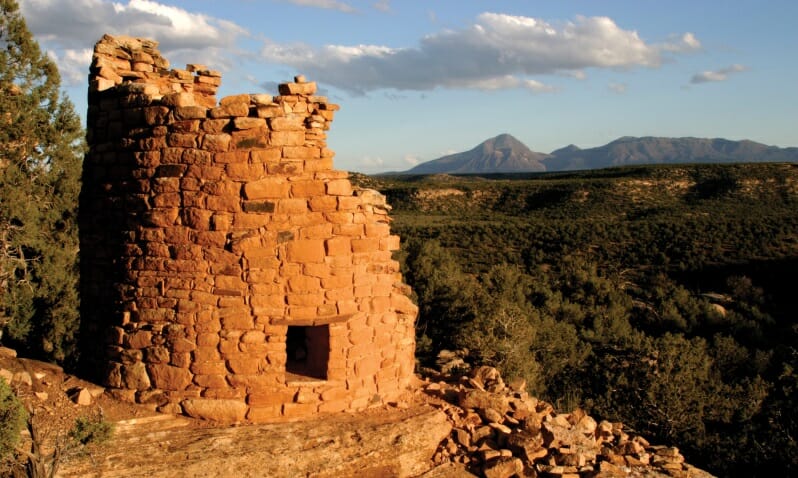
From cliff dwellings suspended from red rock canyon walls to 1,000 year old Great Houses perched upon high mesa tops 7,000 feet above sea level- the four corners of the southwest is rich with cultural heritage.
Discover the sacred land of the ancient Puebloan civilization in some of the most awe-inspiring landscapes. Explore preserved petroglyphs, rock wall art, ancient homes, great kivas, ceremonial buildings and much more. Each site on the tour has something spectacular to offer as you walk their primitive pathways back in time.
Whether you are weekend warriors or on an extended vacation, The Tour of Ancients has something for the entire family and will keep you coming back for more.

Anasazi Heritage Center
The Anasazi Heritage Center is Southwest Colorado’s premier archaeological museum, operated by the Bureau of Land Management since 1988. The Anasazi Heritage Center is a museum focusing on Ancestral Puebloan, Native American, and historic cultures in the Four Corners region. It is also headquarters for visitors traveling to Canyons of the Ancients National Monument.

Aztec Ruins National Monument
Pueblo people describe this site as part of their migration journey. Today you can follow their ancient passageways to a distant time and explore a 900-year old ancestral Pueblo Great House of over 400 masonry rooms. Look up and see original timbers holding up the roof. Search for the fingerprints of ancient workers in the mortar and listen for an echo of ritual drums in the reconstructed Great Kiva.

Canyon of the Ancients National Monument
Canyons of the Ancients National Monument, located in the Four Corners region of southwestern Colorado, encompasses 176,000 acres of federal land administered by the Bureau of Land Management (BLM). The Monument contains the highest known archaeological site density in the United States and has been used or inhabited by humans, including the Northern Ancestral Puebloan culture (or Anasazi), for 10,000 years, and continues to be a landscape used by humans today. Historic uses of the Monument include recreation, hunting, livestock grazing and energy development.

Chaco Canyon National Historical Park
Chaco Canyon hosts the densest and most exceptional concentration of pueblos in the American Southwest and the park preserves one of the most important pre-Columbian cultural and historical areas in the United States. Today the massive buildings of the ancestral Pueblo peoples still testify to the organizational and engineering abilities not seen anywhere else in the American Southwest. For a deeper contact with the canyon that was central to thousands of people between 850 and 1250 A.D., come and explore Chaco through guided tours, hiking & biking trails, evening campfire talks, and night sky programs.

Chimney Rock National Monument
This undiscovered gem is an intimate, off-the-beaten-path archaeological site located at the southern edge of the San Juan Mountains in Southwestern Colorado. Archaeological ruins and artifacts, abundant wildlife, and its setting in the breathtaking San Juan National Forest make Chimney Rock a must-see. Chimney Rock covers seven square miles and preserves 200 ancient homes and ceremonial buildings, some of which have been excavated for viewing and exploration. Chimney Rock is the highest in elevation of all the Chacoan sites, at about 7,000 feet above sea level.

Crow Canyon Archaeological Center
The Crow Canyon Archaeological Center is located on a 170-acre campus about 4 miles northwest of the town of Cortez in southwestern Colorado. Campus facilities include the Gates Archaeology Laboratory, which houses classrooms, education and research laboratories, offices, and a small gift shop and a lodge. Two learning centers—one a replica of an ancient pithouse, the other a reconstructed pueblo—overlook campus from opposite hillsides. Crow Canyon is open to drop-in visitors from April 1 through October 31, Monday through Friday, 8:00 a.m. to 5:00 p.m.

Hovenweep National Monument
Once home to over 2,500 people, Hovenweep includes six prehistoric villages built between A.D. 1200 and 1300. Explore a variety of structures, including multistory towers perched on canyon rims and balanced on boulders. The construction and attention to detail will leave you marveling at the skill and motivation of the builders.

Mesa Verde National Park
Mesa Verde, Spanish for green table, offers a spectacular look into the lives of the Ancestral Pueblo people who made it their home for over 700 years, from AD 600 to 1300. Today the park protects nearly 5,000 known archeological sites, including 600 cliff dwellings. These sites are some of the most notable and best preserved in the United States. Mesa Verde is open year-round, but some areas are seasonal. To make the most of your trip, see what’s available at the time of your visit.

Salmon Ruins Museum
Salmon Ruins is an 11th Century Chacoan Outlier, an interactive museum, an historic homestead complex and a series of reconstructions representing the people who have called northwest New Mexico home during the past 15,000 years. Walk along a half-mile trail and experience a different time and culture with nearly every step.

Ute Mountain Tribal Park
The Ute Mountain Tribal Park offers an in-depth experience not to be missed. Tribal members interpret tribal culture, pictographs, cliff dwellings, surface ruins, and artifacts. It has been selected by National Geographic Traveler as one of “80 World Destinations for Travel in the 21st Century,” one of only nine places in the United States to receive this special designation. The Park encompasses approximately 125,000 acres around a 25-mile stretch of the Mancos River, and is located in the Mesa Verde/Mancos Canyon area just outside the boundaries of the National Park.

